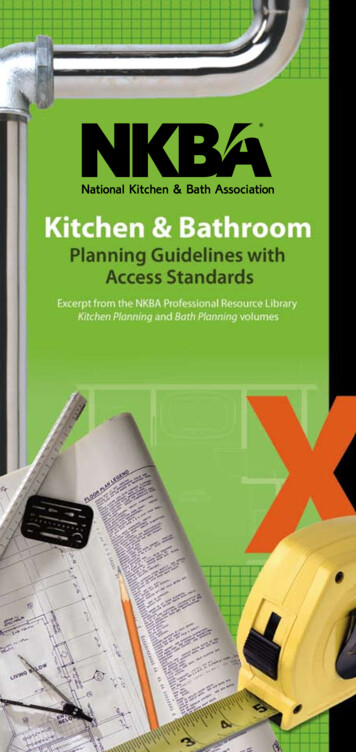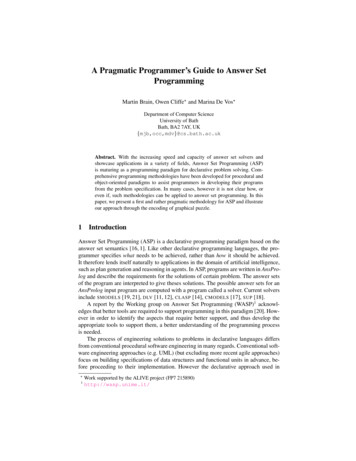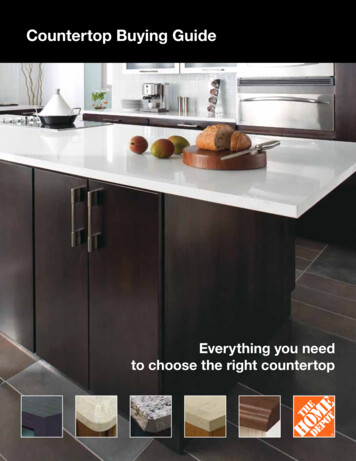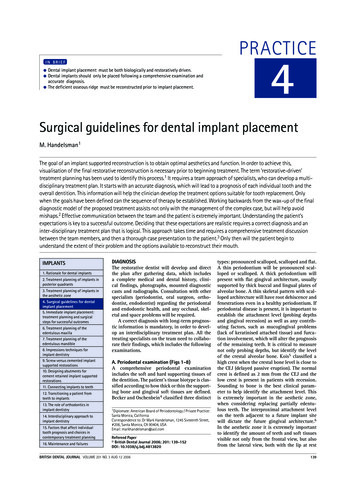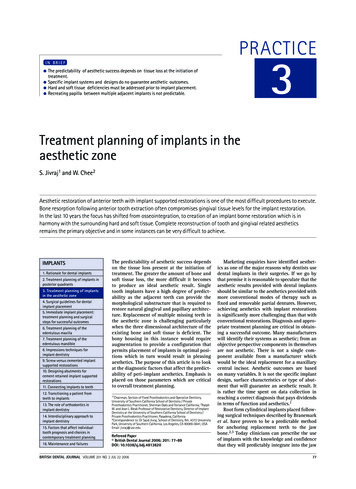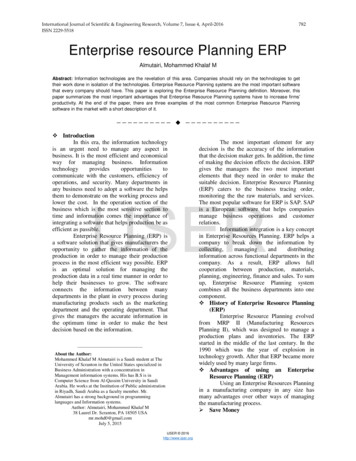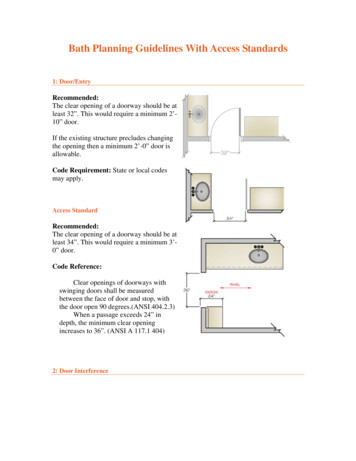
Transcription
Bath Planning Guidelines With Access Standards1: Door/EntryRecommended:The clear opening of a doorway should be atleast 32”. This would require a minimum 2’10” door.If the existing structure precludes changingthe opening then a minimum 2’-0” door isallowable.Code Requirement: State or local codesmay apply.Access StandardRecommended:The clear opening of a doorway should be atleast 34”. This would require a minimum 3’0” door.Code Reference:Clear openings of doorways withswinging doors shall be measuredbetween the face of door and stop, withthe door open 90 degrees.(ANSI 404.2.3)When a passage exceeds 24” indepth, the minimum clear openingincreases to 36”. (ANSI A 117.1 404)2: Door Interference
Recommended:See Code Reference.Code Requirement:No entry or fixture doors shouldinterfere with one another and/or the safeuse of the fixtures or cabinets. (IRC P2705.1.6)Access standardRecommended:The door area should include clear floorspace for maneuvering which variesaccording to the type of door and thedirection of approach.Code Reference:For a standard hinged door or aswinging door, the minimum clearance onthe pull side of the door should be thewidth of the door plus 18” by 60”. (ANSIA 117.1 404.2.3.1)The minimum clearance on the pushside of the door should be the width of thedoor by 48”. (ANSI A 117.1 404.2.3.1)
3: Ceiling HeightRecommended:See Code RequirementCode Requirement:Bathrooms shall have a minimumfloor to ceiling height of 80” over thefixture and at the front clearance area forfixtures.A shower or tub equipped with ashowerhead shall have a minimum floorto ceiling height of 80” above a minimumarea 30” x 30” at the showerhead.Access StandardRecommended:Bathroom guideline code requirement meetsaccess standard.4: Clear Space
Recommended:Plan a clear floor space of at least 30” fromthe front edge of all fixtures (i.e., lavatory,toilet, bidet, tub and shower) to any oppositebath fixture, wall or obstacle.Code Requirement:A minimum space of at least 21”must be planned in front of lavatory,toilet, bidet and tub. (IRC P 2705.1.5)A minimum space of at least 24”must be planned in front of a showerentry. (IRC R 307.1)Access StandardRecommended:Plan a minimum clear floor space of 30” x48” at each fixture, plus space formaneuvering including approach and turningfor a person using a wheelchair.Plan a knee space at the lavatory orworkspace to allow for a seated user.Recommended minimum size of a kneespace is 36” wide x 27” high x 8” deep,increasing to 17” deep in the toe space,which extends 9” from the floor. Insulationfor exposed pipes should be provided.Consider the user’s method of transfer to thetoilet to plan a clear space to fit the user’sneeds.Code Reference:A clear floor space of at least 30”(762 mm) by 48” (1219 mm) should beprovided at each fixture. (ANSI 305.3).Clear spaces can overlap.(ANSI1002.11.2)Include a wheelchair turning spacewith a diameter of at least 60” (1524
mm), which can include knee* and toe*clearances. (ANSI 304.3.1).A wheelchair turning space couldutilize a T-shaped space, which is a 60”square with two 12” wide x 24” deepareas removed from two corners of thesquare. This leaves a minimum 36” widebase and two 36” wide arms. T-shapedwheelchair turning spaces can includeknee* and toe* clearances. (ANSI304.3.2)*Knee clearance must be a minimum 30”wide (36” to use as part of the T-turn) andmaintain a 27” clear space under thecabinet, counter or sink for a depth of 8”.The next 11” of depth may slope down to aheight of 9”, with a clear space of at least17” extending beneath the element. (ANSI306.3)*Toe clearance space under a cabinet orfixture is between the floor and 9” (229 mm)above the floor. Where toe clearance isrequired as part of a clear floor space, thetoe clearance should extend 17” minimumbeneath the element. (ANSI 306.2)GroomingThe clear floor space should becentered on the lavatory. (ANSI1002.10.1)Bathing and ShoweringClearance in front of bathtubs shouldextend the length of the bathtub and be atleast 30” (762 mm) wide. (ANSI 607.2)Code Reference:Bathing and ShoweringWhen a permanent seat is providedat the head of the bathtub, the clearance
should extend a minimum of 12” (305mm) beyond the wall at the head end ofthe bathtub. (ANSI 607.2)The clearance in front of the transfertype shower compartment should be atleast 48” (1219 mm) long measured fromthe control wall and 36” (914 mm) wide.(ANSI 608.2)The clearance in front of a roll-intype shower compartment should be atleast 60” (1524 mm) long next to the openface of the shower compartment and 30”(762 mm) wide. (ANSI 608.2)ToiletingWhen both a parallel and a forwardapproach to the toilet are provided, theclearance should be at least 56” (1422mm) measured perpendicular from therear wall, and 60” (1524 mm) measuredperpendicular from the sidewall. No otherfixture or obstruction should be within theclearance area. (ANSI 604.3.1,1002.11.5.2.3)
5: Lavatory PlacementRecommended:The distance from the centerline of thelavatory to the sidewall/tall obstacle shouldbe at least 20”.Code Requirement:The minimum distance from thecenterline of the lavatory to a wall is 15”.(IPC 405.3.1)The minimum distance between awall and the edge of a freestanding orwall-hung lavatory is 4”. (IRC R 307.1)Access StandardRecommended:
Bathroom guideline recommendation meetsaccess standard.6: Double Lavatory Placement
Recommended:The distance between the centerlines of twolavatories should be at least 36”.Code Requirement:The minimum distance between thecenterlines of two lavatories should be atleast 30”. (IPC 405.3.1)The minimum distance between theedges of two freestanding or wall-hunglavatories is 4”. (IRC R 307.1)Access StandardRecommended:Bathroom guideline recommendation meetsaccess standard.7: Lavatory/Vanity HeightRecommended:The height for a lavatory varies between 32”– 43” to fit the user.Code Requirement: State or local codesmay apply.Access StandardRecommended:Lavatory controls should be within theuser’s reach and operable with minimaleffort.Code Reference:The front of the lavatory sink shouldbe no more than 34” (864 mm) above thefloor, measured to the higher of thefixture or counter surface. (ANSI 606.3)
Lavatory controls should be operablewith one hand and not require tightgrasping, pinching, or twisting of thewrist. (ANSI 309.4)8: CounterRecommended:Specify clipped or round corners rather thansharp edges on all counters.Code Requirements: State or local codesmay apply.Access StandardRecommended:Bathroom guideline recommendation meetsaccess standard.9: Shower SizeRecommended:The interior shower size is at least 36” x36”.Code Requirement:The minimum interior shower size is30” x 30” or 900 square inches, in whicha disc of 30” in diameter must fit. (IRC P2708.1, IPC 417.4)Access StandardRecommended:Plan either a transfer* or a roll-in** shower.*A transfer shower, (36” x 36”) provides
support to a standing person or one who canstand to transfer.**A roll-in shower is a waterproof arealarge enough for a person in a wheelchair toremain in the chair to shower. A preferredminimum size for roll-in shower is 36” –42” x 60”.Recommended:Roll-in shower entries: For a 60” deepshower, a 32” wide entry is adequate. For a42” deep shower, the entry must be at least36” wide to allow for turning space.Code Reference:Transfer-type shower compartmentsshould have an inside finished dimensionof 36” (914 mm) x 36” (914 mm), andhave a minimum of 36” (914 mm) wideentry on the face of the showercompartment. A seat must be providedwithin the 36” x 36” area. (ANSI 608)Roll-in-type shower compartmentsshould have a minimum inside finisheddimension of at least 30” (762 mm) wideby 60” (1524 mm) deep, and have aminimum of a 60” (1524 mm) wide entryon the face of the shower compartment.(ANSI 608.2.2)
10: Tub/Shower ControlsRecommended:a.The shower controls should beaccessible from both inside and outsidethe shower spray and be located between38” – 48” above the floor depending onuser’s height.b.The tub controls should be accessiblefrom both inside and outside the tub andbe located between the rim of the bathtuband 33” above the floor.Code Requirement:State or local codes may apply.
Access StandardRecommended: Controls should be offsettowards the room and easy to grasp, as withlever or loop handles (a and b).Hot and cold should be identified with redand blue indicators.Provide a handheld spray at a heightaccessible to the user (b).Code Reference:Tub/shower controls should beoperable with one hand and not requiretight grasping. (ANSI 309.4)Controls should be on an end wall ofthe bathtub, between the rim and grab bar,and between the open side of the bathtuband the mid-point of the width of the tub.(ANSI 607.5) (a)Controls in roll-in showers should beabove the grab bar, but no higher than 48”(1219 mm) above the shower floor. Intransfer type shower compartments,controls, faucets, and the shower unitshould be on the sidewall opposite theseat, between 38” (965 mm) and 48”(1219 mm) above the shower floor.(ANSI 608.5) (b)A handheld spray unit should beprovided with a hose at least 59” (1499mm) long that can be used as a fixedshowerhead and as a handheld shower. Intransfer type showers, the controls andshower unit should be on the control wallwithin 15” (381 mm) of the centerline ofthe seat (c). In roll-in type showers,shower spray units mounted on the backwall should be no more than 27” from thesidewall. If an adjustable heightshowerhead mounted on a vertical bar isused, the bar should not obstruct the use
of the grab bars. (ANSI 608.6)11: Shower/Tub Control ValvesRecommended: See belowCode Requirement:Shower and tub/shower control valves mustbe one of the following:pressure balancedthermostatic mixingcombination pressurebalance/thermostatic mixing valve types(IRC P2708.3)Access StandardRecommended:Bathroom guideline code requirement meetsaccess standard.12: Shower/Tub Seat
Recommended:Plan a seat within the shower that is 17” –19” above the shower floor and 15” deep.Code Requirement:Shower seat must not infringe on theminimum interior size of the shower (900square inches). (IRC P 2708.1)Access StandardRecommended: Plan a seat in the showerand/or bathtub to fit the parameters of thespace and the needs of the user.Code Reference:A removable in-tub seat should be atleast 15” (381mm) – 16” (406 mm) deepand capable of secure placement. (ANSI610.2)A permanent tub seat should be atleast 15” (381 mm) deep and positioned atthe head end of the bathtub. The top of theseat should be between 17” (432 mm) and19” (483 mm) above the bathroom floor.(ANSI 610.2)Where a seat is provided in a roll-inshower, it should be a folding type and onthe wall adjacent to the controls. The topof the seat should be between 17” (432mm) and 19” (483 mm) above thebathroom floor.In a transfer-type shower, the seatshould be a folding type and extend fromthe back wall to a point within 3” (76mm) of the shower entry. (ANSI 610.3)The materials and installation of theshower and/or bathtub seat must support aminimum of 250 pounds of pressure.(ANSI 610.4)
13: Tub/Shower SurroundRecommended:The wall area above a tub or shower panshould be covered in a waterproof materialextending at least 3” above the showerheadrough in.Code Requirement:The wall area above a tub or showerpan must be covered in a waterproofmaterial to a height of not less than 72”above the finished floor. (IPC 417.4.1,IRC R 307.2)Access StandardRecommended:Bathroom guideline recommendation meetsaccess standard.14: Grab BarsRecommended:Plan grab bars to facilitate access to andmaneuvering within the tub and showerareas.Tub and shower walls should be prepared(reinforced) at time of construction to allowfor installation of grab bars to support astatic load of 250 lbs.Grab bars should be placed at least 33” –36” above the floor.Grab bars must be 11 4” to 2” in diameterand extend 11 2” from the wall.
Access StandardRecommended: Walls throughout thebathroom should be prepared (reinforced) attime of construction to allow for installationof grab bars to support a minimum of 250lbs. of pressure.Grab bars should be placed according to theneeds and height of the user, particularlynear the tub/shower and the toilet.Code Reference:Grab bars should be installed at thetub, shower, and toilet according to thefollowing:Bathtubs with permanent seats: Twohorizontal grab bars (a1) should beprovided on the back wall, one between33” (838 mm) and 36” (914 mm) abovethe floor and the other 9” above the rim ofthe bathtub (a2). Each grab bar should beno more than 15” (381 mm) from the headend wall or 12” (305 mm) from the footend wall. A grab bar 24” (610 mm) longshould be provided on the foot end wall atthe front edge of the bathtub. (ANSI607.4.1)Bathtubs without permanent seats:Two horizontal grab bars should beprovided on the back wall, one between33” (838 mm) and 36” (914 mm) abovethe floor and the other 9” above the rim ofthe bathtub (a3). Each grab bar should beat least 24” (610 mm) long and no morethan 24” (610 mm) from the head endwall or 12” (305 mm) from the foot endwall. A grab bar 24” (610 mm) longshould be provided on the foot end wall atthe front edge of the bathtub. A grab bar12” (305 mm) long should be provided onthe head end wall at the front edge of thebathtub (a4). (ANSI 607.4.2)
Transfer-type showers: Grab barsshould be mounted in a horizontalposition, between 33” and 36” above thefloor, across the control wall and acrossthe back wall to a point 18” from thecontrol wall. (ANSI 608.3.1) (b)Roll-in type shower: Grab barsshould be mounted in a horizontalposition, between 33” and 36” above thefloor, on all three walls of the shower, butnot behind a seat. Grab bars should be nomore than 6” from each adjacent wall.(ANSI 608.3.2) (c1, c2 and c3)Toilet: Grab bars should be providedon the rear wall and on the sidewallclosest to the toilet. The sidewall grab barshould be at least 42” (1067 mm) longand located between 12” (305 mm) and54” (1372 mm) from the rear wall. Therear grab bar should be at least 24” (610mm) long, centered on the toilet. Wherespace permits, the bar should be at least36” (914 mm) long, with the additionallength provided on the transfer side of thetoilet. (ANSI 604.5) (d1 and d2)
15: GlazingRecommended: See Code RequirementCode Requirement:Glass used in tub or showerenclosures (i.e. tub or shower door) orpartitions must be tempered or anapproved equal and must be permanentlymarked as such. (IRC R 308.1)If the tub or shower surround hasglass windows or walls, the glazing mustbe tempered glass or approved equalwhen the bottom edge of glazing is lessthan 60” above any standing or walkingsurface. (IRC R 308.4.5)Any glazing (i.e. windows or doors)whose bottom edge is less than 18” abovethe floor must be tempered glass or
approved equal. (IRC R 308.4.7.2)Access StandardRecommended:Bathroom guideline code requirements meetaccess standard.16: Tub/Shower DoorRecommended:See Code RequirementCode Requirement:Hinged shower doors shall openoutward. (IRC P 2708.1)Access StandardRecommended:Minimize thresholds at the shower entry tono more that 1 2”.Code Reference:Shower compartment thresholdsshould be no more than 1 2” (13 mm)high. Changes in level of no more than1 4” (6 mm) high are permitted, butchanges in level between 1 4” (6 mm)high and 1 2” (13 mm) high should bebeveled with a slope not steeper than 1:2.(ANSI 608.7.303)17: Steps
Recommended:Steps should not be placed outside a tub.If steps are used a grab bar/handrail ismandatory.Access StandardRecommended:Bathroom guideline recommendation meetsaccess standard18: FlooringRecommended:Slip-resistant surfaces should be specifiedfor the general bath flooring, shower floors,and tub/shower bottoms.Code Requirement:State or local codes may apply.Access StandardRecommended: Bathroom guidelinerecommendation meets access standard.Code Reference:Plan a slope for the bathtub orshower drain with a maximum slope of1:48 pitch 1 4 inch per foot(ratio 1:48).(ANSI 403.3)19: Equipment Access
Recommended:See belowCode Requirement:All equipment, including accesspanels, must be installed as permanufacturers’ specifications. (IRC M2720.1)All manufacturers’ instructions mustbe available for installers and inspectorsand left for homeowners. (IRC P 1307.1)Access StandardRecommended:Bathroom guideline code requirement meetsaccess standard.20: Toilet/Bidet PlacementRecommended:The distance from the centerline of toiletand/or bidet to any bath fixture, wall orother obstacle should be at least 18”.Code Requirement:A minimum distance of 15” isrequired from the centerline of toiletand/or bidet to any bath fixture, wall orother obstacle. (IRC R 307.1, IRC P2705.1.5, IPC 405.3.1)Access StandardRecommended:The recommended toilet height is between15” and 19” high.
Code Reference:The toilet should be centered 16” to18” from a side wall. (ANSI 1002.11.5)The toilet seat should be between15” and 19” from the floor. (ANSI1002.11.5.3)
21: Toilet CompartmentRecommended:The size for a separate toilet compartmentshould be at least 36” x 66” with a swingout or pocket door.Code Requirement:The minimum size for a separatetoilet compartment is 30” x 60”. (IPC405.3.1)Access StandardRecommended:To maximize access, provide privacy in thetoileting area without using a separatecompartment.Code Reference:Wheelchair accessible compartmentsshould be at least 60” (1524 mm) wide,
measured perpendicular to the sidewall,and 56” (1422 mm) deep for a wall hungtoilet and at least 59” (1499 mm) deep fora floor-mounted toilet measuredperpendicular to the rear wall. (ANSI604.8.1.1)22: Storage
Recommended:Provide adequate, accessible storage fortoiletries, bath linens, grooming and generalbathroom supplies at point of use.Code Requirement:State or local codes may apply.Access StandardRecommended:Plan storage of frequently used items 15” to48” above the floor.Code Reference:Where a forward or side reach isunobstructed, the high reach should be48” maximum and the low reach shouldbe 15” minimum above the floor. (ANSI308.2.1, 308.3.1)Where a forward or side reach isobstructed by a 20” – 25” deep counter,the high reach should be 44” maximum.(ANSI 308.2.2, 308.3.2)Door/drawer pulls should beoperable with one hand, require only aminimal amount of strength for operation,and should not require tight grasping.(ANSI 309.4)23: Accessories
Recommended:a.Place a mirror above or near thelavatory at a height that takes the user’seye height into consideration.b.The toilet paper holder should belocated 8” – 12” in front of the edge ofthe toilet bowl, centered at 26” above thefloor.c.Additional accessories, such as towelholders, soap dishes, etc., should beconveniently located near all bathfixtures.Code Requirement:State or local codes may apply.Access StandardRecommended:a.Plan a full height mirror to providereflection at eye level, regardless of theuser’s height or stature.b.See code reference on toilet paperplacement.c.Accessories should be placedbetween 15” and 48” above the floor, andoperable with a closed fist and withminimal effort.Code Reference:Mirrors above lavatories should havethe bottom edge of the reflecting surfaceno more than 40” (1016 mm) above thefloor. (ANSI 603.3) (a)The toilet paper holder should be 7”– 9” in front of the toilet bowl andbetween 15” (381 mm) and 48” (1219mm) above the floor. There should be aclearance of at least 11 2” (38 mm) belowor 12” (305 mm) above the grab bar.(ANSI 604.7) (b)
See Access Standard 22 for reachspecifications.24: Electrical ReceptaclesRecommended:All GFCI receptacles should be located atelectrical appliance points of use.Code Requirement:At least one GFCI protectedreceptacle must be installed within 36” ofthe outside edge of the lavatory. (IRC E3801.6)All receptacles must be protected byground fault circuit interrupters (GFCI).(IRC 3802.1)A receptacle shall not be installedwithin a shower or bathtub space. (IRC E3902.11)
Switches shall not be installed withinwet locations in tub or shower spaces orwithin reach while standing in the tub orshower unless installed as part of thelisted tub or shower assembly. (IRC E3901.7)Access StandardRecommended: See Code Reference.Code Reference:See Access Standard 22 forspecifications for placement within reachrange.25: LightingRecommended:In addition to general lighting, task lightingshould be provided for each functional areain the bathroom (i.e. grooming, showering).Code Requirement:At least one wall-switch controlledlight must be provided. Switch must beplaced at the entrance of the bathroom.(IRC E 3901.6, IRC E 3803.2)All light fixtures installed within tuband shower spaces should be marked“suitable for damp/wet locations” (IRC E3903.8.)Hanging fixtures cannot be locatedwithin a zone of 3’ horizontally and 8’vertically from the top of the bathtub rimor shower stall threshold. (IRC E3903.10)
Access StandardRecommended: Task lighting at the vanityshould be beside the mirror and at eye leveland with the lamp not visible to the eye.Lighting controls should be between 15” and48” above the floor and operable with aclosed fist and with minimal effort.Code Reference:Operable parts should be operablewith one hand and not require tightgrasping, pitching, or twisting of thewrist. The force required to activateoperable parts should be 5 poundsmaximum. (ANSI A117.1 309.4)See Access Standard 22 forspecifications for reach range for controls.26: VentilationRecommended:Plan a mechanical exhaust system, vented tothe outside, for each enclosed area.Code Requirement:Minimum ventilation for thebathroom is to be a window of at least 3sq. ft. of which 50% is operable, or amechanical ventilation system of at least50 cubic feet per minute (cfm) ducted tothe outside. (IRC R 303.3, IRC M 1506.3)Access StandardRecommended:Ventilation controls should be placed 15” –
48” above the floor, operable with minimaleffort, easy to read, and with minimal noisepollution.Code Reference:See Access Standard 25 for operablecontrols.See Access Standard 22 for reachrange for controls.27: HeatRecommended:A supplemental heat source, i.e., heat lamp,toe kick heater, or floor heat should beconsidered.Code Requirement:All bathrooms should have anappropriate heat source to maintain aminimum room temperature of 68 degreesFahrenheit (20 Celsius). (IRC R 303.8)Access StandardRecommended:See Code Reference.Code Reference:See Access Standard 25 for operablecontrols.
Access Standard 22 for reach rangefor controls.
mm), which can include knee* and toe* clearances. (ANSI 304.3.1). A wheelchair turning space could utilize a T-shaped
